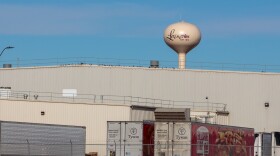The Midwest is at-risk of increased water pollution from fertilizer run-off during the winter, according to a new study from the Gund Institute for Environment at the University of Vermont.
“We figured out that we've got more than 40% of the United States that's potentially creating this winter pollution every time it rains or snow melts in the winter,” said Carol Adair, a University of Vermont researcher who worked on the study.
Nitrogen and phosphorus run-off has been known to pollute waters. It can cause algae blooms that make recreational swimming beaches dangerous and creates dead zones that kill fish.
In the past, much of the focus on nutrient run-off has been during the growing season.
Nitrogen and phosphorus froze on farmland during winters, keeping it from polluting waters until the plants could absorb them in the spring. Now winters are warming faster than any other season across the Midwest. Warmer temperatures are thawing the soil and heavy rainfall events are washing those chemicals into waterways.
“Winter events tend to carry a little bit more pollution than the same size event in the growing season,” Adair said. “That's largely because there are no plants around taking things up.”
The Upper Midwest is particularly at-risk, partly because it is both rich in nutrients from the agriculture in the region and also because it is seeing more heavy rainfall events on top of snow during the winter. In the past, winter rainfall was more common in more southern parts of the Midwest, such as Missouri and Kansas, according to Dennis Todey, the director of the USDA Midwest Climate Hub.
“The further north you go, snow was more predominant during the wintertime,” said Todey. ”But that line has moved northwards so that we can see rainfalls throughout a good portion of the Midwest throughout the winter.”

The study looked in particular at the Mississippi River floods that occurred during the winter and early spring of 2019 and found that “rain-on-snow” events released a massive amount of nutrients and sediment into the river, which contribute to the dead zone that’s killing fish in the Gulf of Mexico.
“If we know where this is coming from – even just using these maps – we could start to think about where to pinpoint in order to try to control it and figure out where the problems are,” Adair said.
Riparian buffer strips and cover crops can help keep these nutrients out of the waterways. Farmers can also help mitigate the problem by not applying manure and nitrogen to fields in the fall.
“If you're losing the nitrogen to the water, that's nitrogen that you don't have available for your crop, so it's a lose-lose in that situation,” Todey said.
Eva Tesfaye covers agriculture, food systems and rural issues for KCUR and Harvest Public Media and is a Report For America corps member. Follow Eva on Twitter @EvaRTesfaye.
This story was produced in partnership with Harvest Public Media, a collaboration of public media newsrooms in the Midwest. It reports on food systems, agriculture and rural issues. Follow Harvest on Twitter: @HarvestPM
Copyright 2022 KCUR 89.3. To see more, visit KCUR 89.3. 9(MDA4OTAxNzAzMDEzMjc0MTc2MzA5ZDZlMw004))







